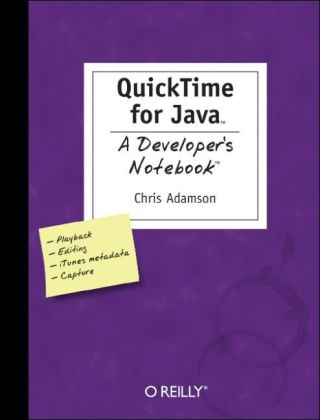
QuickTime for Java - A Developer's Notebook
O'Reilly Media (Verlag)
978-0-596-00822-2 (ISBN)
- Titel ist leider vergriffen;
keine Neuauflage - Artikel merken
QuickTime Java (QJT) is a terrific multimedia toolkit, but it's also terrifying to the uninitiated. Java developers who need to add audio, video, or interactive media creation and playback to their applications find that QTJ is powerful, but not easy to get into. In fact, when it comes to class-count, QuickTime Java is nearly as large as all of Java 1.1. Once you learn the entire scope of Apple's QuickTime software, you really appreciate the problem. At its simplest, QuickTime allows Mac and Windows users to play audio and video on their computers. But QuickTime is many things: a file format, an environment for media authoring, and a suite of applications that includes browser plug-ins for viewing media within a web page, a PictureViewer for working with still pictures, QuickTime Streaming Server for delivering streaming media files on the Internet in real time, and QuickTime Broadcaster for delivering live events on the Internet. Among others. As if that weren't daunting enough, the javadocs on QJT are wildly incomplete, and other books on the topic are long out of date and not well regarded, making progress with QTJ extremely difficult. So what can you do?
Our new hands-on guide, QuickTime Java: The Developer's Notebook, not only catches up with this technology, but de-mystifies it. This practical "all lab, no lecture" book is an informal, code-intensive workbook that offers the first real look at this important software. Like other titles in our Developer's Notebook series, QuickTime Java: The Developer's Notebook is for impatient early adopters who want get up to speed on what they can use right now. It's deliberately light on theory, emphasizing example over explanation and practice over concept, so you can focus on learning by doing. QuickTime Java: The Developer's Notebook gives you just the functionality you need from QTJ. Even if you come to realize that 95 per cent of the API is irrelevant to you, this book will help you master the 5 per cent that really counts.
Chris Adamson is an Associate Online Editor for O'Reilly's Java websites, ONJava and java.net. He is also a software consultant, in the form of Subsequently and Furthermore, Inc., specializing in Java, Mac OS X, and media development. He wrote his first Java applet in 1996 on a 16 MHz black-and-white PowerBook 160 with the little-seen Sun MacJDK 1.0. In a previous career, he was a Writer / Associate Producer at CNN Headline News. He has an MA in Telecommunication from Michigan State University, and a BA in English and BS in Symbolic Systems from Stanford University.
Preface Chapter 1. Getting Up and Running with QuickTime for Java; Setting Up QTJ on Windows Embedding QuickTime in HTML Preflighting a QTJ Installation Compiling QTJ Code Opening and Closing the QuickTime Session Playing an Audio File from the Command Line Chapter 2. Playing Movies Building a Simple Movie Player Adding a Controller Getting a Movie-Playing JComponent; Controlling a Movie Programmatically Showing a Movie's Current Time; Listening for Movie State-Changes Moving Frame by Frame; Playing Movies from URLs Preventing "Tasking" Problems Chapter 3. Editing Movies Copying and Pasting Performing "Low-Level" Edits Undoing an Edit Undoing and Redoing Multiple Edits; Saving a Movie to a File Flattening a Movie Saving a Movie with Dependencies Editing Tracks Chapter 4. Working with Components; Specifying a Component's Type Exporting Movies Exporting Movies to Any Installed Format Importing and Exporting Graphics Discovering All Installed Components Chapter 5. Working with QuickDraw Getting and Saving Picts Getting a Pict from a Movie; Converting a Movie Image to a Java Image A Better Movie-to-Java Image Converter Drawing with Graphics Primitives Getting a Screen Capture Matrix-Based Drawing Compositing Graphics; Chapter 6. Capture Capturing and Previewing Audio Selecting Audio Inputs Capturing Audio to Disk Capturing Video to Disk; Capturing Audio and Video to the Same File Making a Motion Detector Chapter 7. Audio Media Reading Information from MP3 Files Reading Information from iTunes AAC Files Providing Basic Audio Controls Providing a Level Meter Building an Audio Track from Raw Samples Chapter 8. Video Media Combining Video Tracks Overlaying Video Tracks Building a Video Track from Raw Samples Chapter 9. Miscellaneous Media Creating Captions with Text Media Creating Links with HREF Tracks Adding Timecodes; Creating Zero-Source Effects Creating One-Source Effects (Filters); Creating Two-Source Effects (Transitions) Index
| Erscheint lt. Verlag | 22.2.2005 |
|---|---|
| Reihe/Serie | A Developer's Notebook |
| Verlagsort | Sebastopol |
| Sprache | englisch |
| Maße | 178 x 229 mm |
| Einbandart | Paperback |
| Themenwelt | Mathematik / Informatik ► Informatik ► Grafik / Design |
| Informatik ► Programmiersprachen / -werkzeuge ► Java | |
| Mathematik / Informatik ► Informatik ► Web / Internet | |
| ISBN-10 | 0-596-00822-8 / 0596008228 |
| ISBN-13 | 978-0-596-00822-2 / 9780596008222 |
| Zustand | Neuware |
| Informationen gemäß Produktsicherheitsverordnung (GPSR) | |
| Haben Sie eine Frage zum Produkt? |
aus dem Bereich


